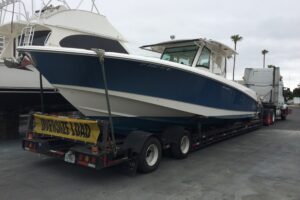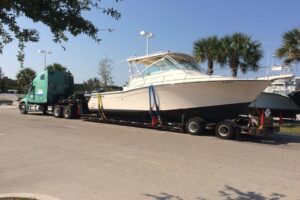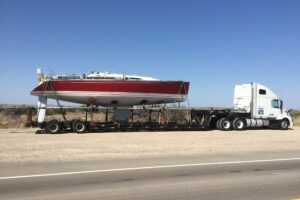Our 40-foot monohull sailboat had been away from home for nine years. Including our family circumnavigation, we had happily cruised in her for 114,000 miles to 114 different countries. Our last two seasons had been spent getting reacquainted with the Eastern Caribbean between the United States and Venezuela. But for a while my husband had wanted the boat back home in Vancouver, primarily to explore the British Columbian and Alaskan coasts.
 There were other considerations too, namely the need for an engine overhaul and interior refurbishing. Also, with the boat in Vancouver, family members could easily join us for cruises and our sons were only too happy to fill any gaps in our timetable-without their parents along.
There were other considerations too, namely the need for an engine overhaul and interior refurbishing. Also, with the boat in Vancouver, family members could easily join us for cruises and our sons were only too happy to fill any gaps in our timetable-without their parents along.
The question was how to deliver the boat and whether to truck, ship or sail her from the Caribbean to the Pacific Northwest. We immediately dismissed the voyage due to the costs and time involved. Not only would we miss a northern sailing season, there would be additional Hurricane boat storage charges and the Panama Canal fee, together with wear and tear on the boat. Along with sailing offshore another 8,000 nautical miles, with minimal stops, a voyage was unappealing.
Shipping the boat from either the Caribbean or Florida, particularly using an easy float-on/float-off system such as that offered by Dockwise Yacht Transport, where minimal work is required, was attractive. But at $26,000, which included the 20-percent, five-month advanced booking discount, it was far more expensive than the land transport option.
Trucking was a familiar choice, as we had trucked her successfully from Florida to Vancouver once before when we concluded our circumnavigation. This time, however, we decided to complete both the decommissioning for transit and re-commissioning on arrival ourselves.
The Boat Dimensions Required were:
Length: Total length including swim platform, bow pulpit, raised out-drives, etc.
Beam: Widest part of the boat including any attachments
Height: The bottom of the keel to the top of the lowest non-removable part of the deck.
Of the 20 replies we received, one company really stood out. We researched references and spoken at length with the companies representatives and truck driver before we signed a contract with YachtTrucking.com. In the end, we were extremely happy with their service. They had no problem providing good references who’s feedback was extremely positive and helpful.
Our quote included delivery of the boat and 10-foot, 6-inch inflatable dinghy from Galveston, Texas, to Bellingham, Washington, where we had found yards capable of hauling the boat and removing the mast, and where we could work on the boat ourselves. Those requiring the decommissioning and recommissioning to be done need to find a yard experienced in the procedure, particularly where there are arches, radar posts, solar panels, wind generators and considerable canvas involved. Facilities needed to be available and contactable for physically loading and unloading the boat from the truck, although we were not required to be there. A pickup in Florida was a more expensive option, partly because of the increased distance but also because more wide-load escorts were needed.
The price also included insurance for the full value of the boat while in transit. This covered any physical damage to the boat, whether by accident or vandalism (including the interior), but did not include theft of personal items. The company could offer extra coverage for this for an additional premium of approximately $25 per $1,000 value, but they preferred that we removed valuable items.
 The trucking company would apply for all the permits to pass through individual states (regulations are complex and varied, as can be seen on www.uship.com) and to arrange wide-load escorts where necessary-all costs included in the price. We were warned, however, that due to unforeseen circumstances such as road work or diversions there could be extra requirements for which there would be an additional cost that we would be charged on arrival (there were none). We were also told there would be delays as most states only allowed wide hauls to travel during daylight hours and sometimes not on weekends. In our case, a long weekend and flooding caused some delays. One of the advantages of using an experienced trucker is that they know the cheaper and less restrictive routes.
The trucking company would apply for all the permits to pass through individual states (regulations are complex and varied, as can be seen on www.uship.com) and to arrange wide-load escorts where necessary-all costs included in the price. We were warned, however, that due to unforeseen circumstances such as road work or diversions there could be extra requirements for which there would be an additional cost that we would be charged on arrival (there were none). We were also told there would be delays as most states only allowed wide hauls to travel during daylight hours and sometimes not on weekends. In our case, a long weekend and flooding caused some delays. One of the advantages of using an experienced trucker is that they know the cheaper and less restrictive routes.
Instructions for Trucking
For the trip, the boat had to conform to certain specifications. To pass under bridges it could only be a certain height. The ideal height was 12 feet, 9 inches, although this could be stretched to 13 feet, 2 inches for transit across the country (maximum legal height is 13 feet, 6 inches). The trailer held the keel nine inches off the ground, so this was subtracted from the allowable boat height. The dinghy can ride on the flatbed beside the boat and should be well wrapped in a tarp.
We were also advised about storage. The mast should be wrapped with carpet, and rigging securely attached and protected. Any loose objects on deck and below, including anchors and chain and personal gear have to be securely stored, preferably all below decks. Although shrink-wrapping helps protect the boat, deck, and interior, it is not recommended by most companies for larger boats as it rips easily at high speed and in the cold.
Decommissioning the Yacht
Research showed that yards commonly charge between $1,500 to $3,000 to unstep the mast and stow the boat. The charge is based on man-hours, so if a superstructure and lifelines need removing the cost will increase. Most yards only give an estimate in case of disassembly difficulties. Labeling, marking and itemizing all equipment and rigging is extremely important for a smooth re-commissioning on arrival and it pays to use a company that does this meticulously, or do it oneself, otherwise, the re-commissioning expense will escalate, as will your own frustration.
Much of the work can be done while the boat is still in the water where living aboard is more comfortable. Galveston Yacht Services was extremely accommodating in letting us moor to one of its docks and we filled it rapidly with gear. It’s truly amazing what can be concealed in the depths of those cockpit lockers.
Before disassembly, we discussed where equipment could be stored and the supplies needed. Duct tape and carpeting were at the top of the list, along with cable ties and plastic bags. Fortunately, the yard could help us with cheap carpeting (one of its slips was taken by the owner of a carpet company) and also with duct tape and cable ties, although these items were more expensive there. Shrink-wrapping was also useful for the boom. By the end of packing, we had used five large rolls of tape along with 30 feet of 12-foot carpet and more than 70 30-inch cable ties-far more than expected.
Removing and preparing the mast ashore was a top priority. After the sails were removed, all lines were detached from the boom-mainsheet, vang, boom break, etc. We shrink-wrapped and duct-taped the boom at intervals before laying it on deck where the ends were also sealed and taped. It was later padded with carpet and lashed in place.
Lines led to the cockpit from the mast-halyards, downhauls, topping lift-were pulled snug to the sheaves and the ends coiled and bagged. Andy climbed the mast steps to attach a hauling strap around the mast under the spreaders (the best balance point) then marked the position of turnbuckles, backstay adjuster, and other attachments with electrical tape before releasing. The forestay, backstay, and upper shrouds were loosened but left attached to hold the mast in place until the hoist was attached. The genoa furling drum was padded with carpeting and taped to prevent damage. We have a keel-stepped mast, so deck chocks and seal were removed at deck level and electrical and antenna cables were
detached below.
Ideally, the yard will have a facility to remove the mast with a tower or crane. Our yard had a jib-boom on the travel lift that took our keel-stepped mast just high enough to raise it out of the boat. It was helpful to have another person to guide the mast.
Preparing the Mast
 With the mast on trestles, the spreaders were removed. All halyards and lines were pulled through to the base of the mast so that shackles or fittings were tight against the sheaves and rope ends coiled and bagged. (Although some suggest completely removing the running rigging, this means much extra work when re-commissioning.) Particular care was taken when securing the furling gear so no movement would occur on the trip. Lights, Windex, electric sensors, and antennas were removed and wrapped, boxed and labeled for stowage. All wire rigging was laid out from the mast and strips of carpeting duct-taped along its length. The rigging was then pulled tight along the carpeting and attached securely with cable ties. It is better that stainless steel is isolated from the aluminum mast as corrosion may occur, particularly in winter from the salt on the roads. All protrusions were covered with carpeting and taped. The coils of halyards were bagged, sealed and tied to the mast. Mast ends were covered and entry points were taped to protect from dust and grit. Some riggers advocate covering the entire mast with bubble wrap (big bubbles) for added protection. Due to our 7-foot, 3-inch draft, much equipment had to be removed from the deck, including the pulpit and stanchions back to the cockpit. The most complex job was removing the arch over the aft end of the cockpit, which supports four solar panels, radar scanner, and wind generator. Even the larger 90-watt solar panels were quite manageable for Andy and me to remove and the rest was only a matter of time. The structure has grown over the years and we took care to mark with tape and make a diagram showing how the many lengths of stainless steel tubes were assembled.
With the mast on trestles, the spreaders were removed. All halyards and lines were pulled through to the base of the mast so that shackles or fittings were tight against the sheaves and rope ends coiled and bagged. (Although some suggest completely removing the running rigging, this means much extra work when re-commissioning.) Particular care was taken when securing the furling gear so no movement would occur on the trip. Lights, Windex, electric sensors, and antennas were removed and wrapped, boxed and labeled for stowage. All wire rigging was laid out from the mast and strips of carpeting duct-taped along its length. The rigging was then pulled tight along the carpeting and attached securely with cable ties. It is better that stainless steel is isolated from the aluminum mast as corrosion may occur, particularly in winter from the salt on the roads. All protrusions were covered with carpeting and taped. The coils of halyards were bagged, sealed and tied to the mast. Mast ends were covered and entry points were taped to protect from dust and grit. Some riggers advocate covering the entire mast with bubble wrap (big bubbles) for added protection. Due to our 7-foot, 3-inch draft, much equipment had to be removed from the deck, including the pulpit and stanchions back to the cockpit. The most complex job was removing the arch over the aft end of the cockpit, which supports four solar panels, radar scanner, and wind generator. Even the larger 90-watt solar panels were quite manageable for Andy and me to remove and the rest was only a matter of time. The structure has grown over the years and we took care to mark with tape and make a diagram showing how the many lengths of stainless steel tubes were assembled.
Although the pulpit was relatively easy to remove, some of the stanchion fasteners were seized and had to be sawn off. Varnished handrails were covered in cloth and taped so the material could not blow off. Forward, the anchor was removed from the bow roller and all anchors and chain were stowed, secured and padded in place in the anchor locker. We had once seen an anchor that had worked its way through the hull from the vibration that occurs in transit. The outboards were taken from the stern pulpit and padded and lashed in the cockpit. On the last day the bimini and dodger were removed and folded and the supports were tied down tightly.
Down below, all items were secured in lockers and padded. The solar panels were stowed on the aft cabin cushions with carpeting in between and wedged tightly. Many other items from the deck were secured and protected. The stove was bolted, all drawers and lockers checked. The fridge was cleaned out and locked open so that air could circulate. Hatches were locked and taped shut, and all air vents and dorades blocked to prevent dust going below.
After hauling Bagheera a few additional items were removed and stowed, such as the wheel, which was too high. The folding propeller was also removed (although fixed propellers are generally left in place rigid). The batteries were turned off along with fuel and seacocks. Looking around the deck as we finally locked the companionway hatch it did not look attractive but nothing was going to chafe or shift. The process had taken five days, but the Galveston heat and humidity forced us to stop work by afternoon.
Re-commissioning
YachtTrucking.com’s Truck Driver kept in constant contact with us during the trip and we met them on arrival in Bellingham. Our boat had traveled well and was in great shape when it arrived. Re-rigging the boat went smoothly at The Landings at Colony Wharf in Bellingham, and in rather cooler temperatures than in Texas. It took three days to re-rig, clean the hull and paint the bottom.
Trucking the boat from Galveston not only allowed us to sail through Central Caribbean, and enjoy the previously unvisited countries of Haiti, Jamaica and the Cayman Islands, we were privileged to be accompanied by a female orca and her newborn when sailing up to Canada before heading north to enjoy the dramatic scenery of Desolation Sound.
If one prepares the boat oneself, trucking is more labor intensive than the shipping option, yet it is considerably less expensive. Delivery by truck is also fast and allowed us to enjoy the best of summer sailing in British Columbia immediately following the winter season in the Caribbean.
We’d like to thank YachtTrucking.com for their timely and professional service.
















